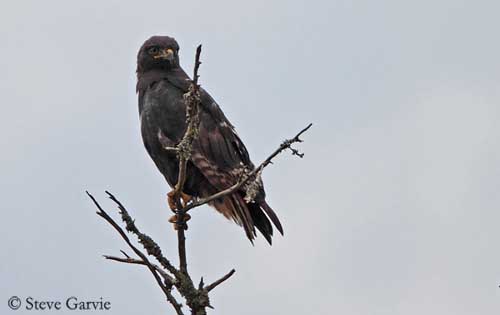
Text by Nicole Bouglouan
Photographers :
Didier Buysse
Vision d’Oiseaux
Jean Michel Fenerole
Photos d’Oiseaux du monde
Steve Garvie
RAINBIRDER Photo galleries
Tom Merigan
Tom Merigan’s Photo Galleries
Ingo Waschkies
My bird pictures on Pbase
Callie de Wet
GALLERY
Sources :
HANDBOOK OF THE BIRDS OF THE WORLD Vol 2 by Josep del Hoyo-Andrew Elliot-Jordi Sargatal - Lynx Edicions - ISBN: 8487334156
BIRDS OF PREY OF AFRICA AND ITS ISLANDS by Alan and Meg Kemp - Struik Publishers - ISBN: 1770073698
BirdLife International (BirdLife International)
Page article Hawks of genus Buteo - Introduction
Hawks of Genus Buteo
Hawks of the world, except Australia
2 - The African buzzards: 5 species + Madagascar
The African buzzards are medium-sized buzzards, with 35-40 to 48-51 centimetres long. They are named “buzzard” instead “hawks” in the Americas.
The Augur Buzzard (Buteo augur) exhibits two different plumages with a melanistic morph more often seen in the eastern part of the range, and a normal morph with dark grey upperparts and white underparts. The dark morph has blackish plumage overall.

The broad wings show black trailing edge and white underside. But the main feature of this species is the bright rufous tail visible in both plumages. The bare parts are yellow and the eyes are dark brown.
The Augur Buzzard occurs in Ethiopia, S to Zimbabwe and W to S Angola and N-C Namibia.
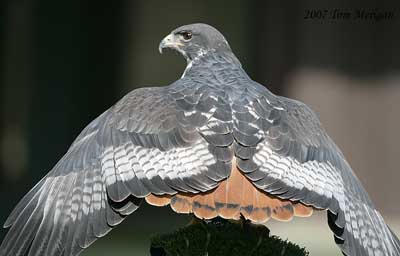
The Archer’s Buzzard (Buteo archeri) is usually considered a subspecies of Augur Buzzard and occurs only in the highlands of N Somalia. But in some classifications, it is evaluated as full species.
This one has dark brown upperparts with chestnut feathers on back and the tail is bright rufous, white throat streaked black and rufous underparts.
Both species frequent the mountainous areas and the hilly savannahs with forest patches. The Augur Buzzard occurs in open woodland and grassland, up to 5000 metres of elevation.
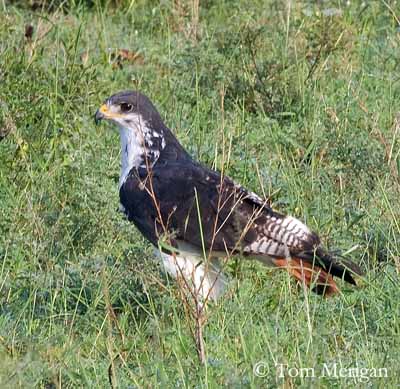
They feed on various small vertebrates, lizards and snakes, small mammals and birds, insects and carrion. They hunt from perches, rock or branch, but they also soar, hover and glide on their broad wings. They rarely hunt by walking on the ground. They may hunt within the forest or over open country.
During the breeding season, the Augur Buzzard performs spectacular aerial and calling displays, suggesting the same behaviour in the Archer’s Buzzard but this one needs more research and observations.
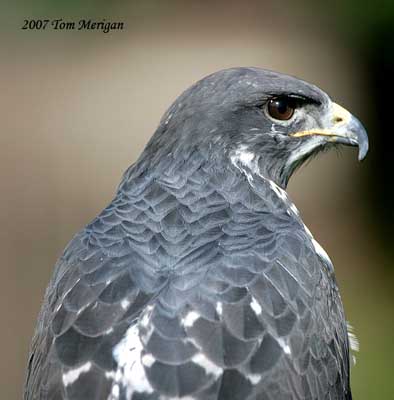
The stick nest is built in tree, or on cliff ledge, and the interior is lined with green leaves. There are usually two eggs and the incubation lasts about 39-40 days. The elder chick often kills the younger sibling. The young fledge 48-55 days after hatching.
The laying occurs at the end of the dry season in Archer’s Buzzard, between late March and early April. The chick has been observed in the nest at the beginning of the rainy season, but the nesting behaviour of this species is poorly known.
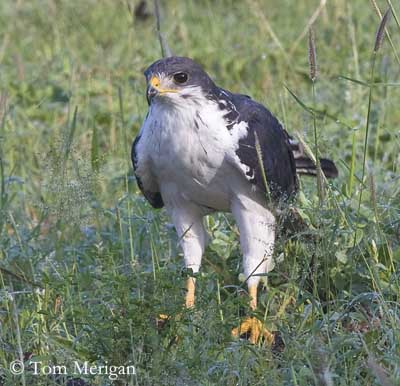
The Augur Buzzard is resident and sedentary, only performing some post-breeding movements.
It is vulnerable to the changes in the habitat with afforestation of grasslands, but the species is able to adapt itself to human developments, even extending its range for nesting and roosting in small exotic plantations.
The Archer’s Buzzard has uncertain status and appears vulnerable in its restricted range.
The Jackal Buzzard (Buteo rufofuscus) is very similar to Archer’s Buzzard, but a pale, almost white morph exists, with a breast patch recalling the Augur Buzzard.
With a wingspan of 130 cm and a length of 55 cm, the Jackal Buzzard is a stocky raptor with broad, large wings. Upperparts and head are black with narrow pale grey bars and black tips on the upperwing. The uppertail feathers are plain rufous.
The underparts are variable with breast usually rufous sometimes with white upper edge, whereas the belly is blackish, narrowly barred white. Undertail-coverts and rectrices are rufous. The bill is black. The eyes are dark brown. Cere, legs and feet are yellow.
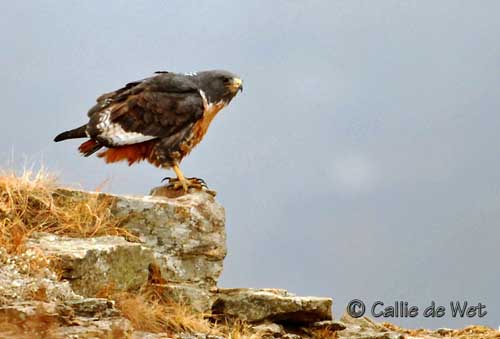
The juvenile has dark brown upperparts with scaled effect and rufous wash on the tail, and paler rufous-brown underparts.
The Jackal Buzzard occurs in South Africa, S and C Namibia, Lesotho, Swaziland, S Mozambique and S Botswana.
This raptor frequents open areas, steppes and grasslands, often in hilly and mountainous regions.
It feeds primarily on small mammals as young hyrax, birds as francolins, also large snakes and lizards, some insects and carrion, mainly during winter.
The Jackal Buzzard often hunts while flying and soaring. It is very agile in flight. It hovers before to dive onto the prey, but it also may hunt from perch.
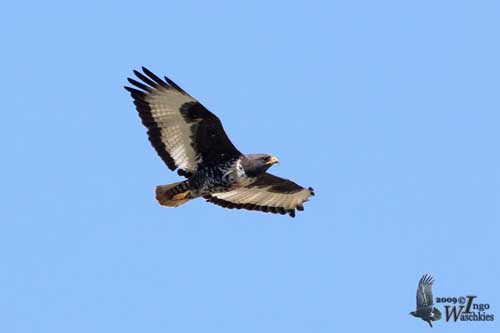
During the breeding season, the pair displays noisily in the air, before to build a large stick nest lined with leaves. This nest is usually placed on a cliff ledge, but sometimes, it may be built in tall tree.
The female lays two eggs and the incubation lasts about 40 days. Only one chick survives, the sibling is often killed by the elder. The young fledge about 50 days after hatching and becomes independent at 70 days of age.
They often roost on rocky ledges in cliffs.
The Jackal Buzzard’s call is similar to that of the Red-tailed Hawk, and also of the jackal, giving the bird its name.
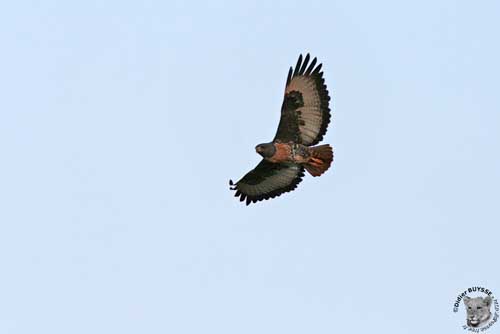
This buzzard does not perform regular movements, but outside the breeding season, adults and juveniles can be seen in plains away from the breeding grounds.
The species is relatively common in the range and evaluated as Least Concern by Birdlife International.
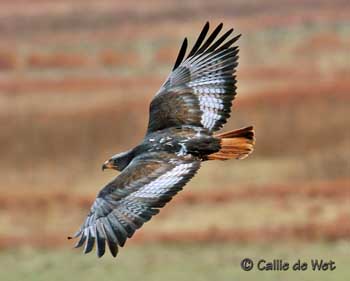
Buteo rufofuscus
Buteo rufofuscus
Buteo rufofuscus
Buteo rufofuscus
The two other species of the African continent, the Mountain Buzzard (Buteo oreophilus) and the Red-necked Buzzard (Buteo auguralis) have almost similar appearance. Both have brown plumage and pale underparts with some differences.
The Mountain Buzzard has brown upperparts with dull chestnut tail, and white underparts heavily spotted dark brown. The tail is finely barred darker on both sides. On the white underwing, the coverts are rufous and the trailing edge is black. The undertail shows a subterminal darker bar. The bare parts are yellow, including the eyes, and the bill is black with yellow cere.
The juvenile is slightly paler and duller, and it has brown eyes.
This buzzard occurs in SW Africa, from the highlands of Ethiopia, S to Tanzania and Malawi. The subspecies B.b. trizonatus is found in S and E Africa.
It frequents mountain forest patches, exotic plantations and close grasslands, from sea-level in S South Africa, up to 4500 metres of elevation northwards.
The Mountain Buzzard performs some movements in S Africa, but appears to be resident in E Africa.
The Red-necked Buzzard has chestnut head and neck, chestnut tail with narrow, black subterminal band and dark grey-brown upperparts. The flight feathers are dark grey with black tips. The underparts are white and heavily spotted dark rufous or brown, and mainly on the breast, until forming dark breast band. The underwing is white with blackish trailing edge. The bill is black. The bare parts are yellow. The eyes are brown.
The juvenile exhibits pale rufous edges on the upperparts giving scaled effect. It lacks the dark breast band and only a few dark spots are visible below. The tail is duller. The eyes are pale yellow.
This buzzard occurs in Sierra Leone, E to Uganda and Ethiopia, and S to N Angola.
The Red-necked Buzzard performs N-S migration in W Africa. It moves southwards in September after the rainy season, to breed along the edges of Guinea and Upper Congo forests.
In March, it moves again N towards drier open savannahs.
Both feed on small mammals, rodents, reptiles and especially chameleons, some small birds, amphibians and insects. They hunt from perch within forest but overlooking open areas for the Mountain Buzzard and in the open for the Red-necked Buzzard. They remain long periods on dead trees or poles, and drop onto the prey on the ground, or take it from the foliage.
They perform acrobatic flight displays accompanied by calls above the forest or the nest-site. The stick nest is a platform in tree, often lined with greenery. The female lays usually 2-3 eggs. Incubation and fledging period in Red-necked Buzzard lasts about 50-60 days, but seems to be longer in Mountain Buzzard. The young remain with their parents for some months after fledging.
Both species are relatively common but they are vulnerable to destruction of the habitat. They are able to adapt to exotic plantations for nesting and hunting. They are not currently globally threatened.
And finally the Madagascar Buzzard (Buteo brachypterus) which occurs on Madagascar Island is fairly similar to the Mountain Buzzard and the typical Eurasian Buzzard (Buteo buteo).
The upperparts are dark brown with darker back. The rump shows pale bars, and we can see a grey wash on the head and white tail base. The underparts are creamy-white with throat, breast, underwing-coverts and flanks heavily streaked brown, whereas centre of belly and vent are white. Thighs are brown finely barred white. Flight feathers and rectrices are brown above and white below, barred dark. The bill is black with blue-grey cere. Eyes, legs and feet are pale yellow.
The juvenile resembles adult but has streaked brown underparts.
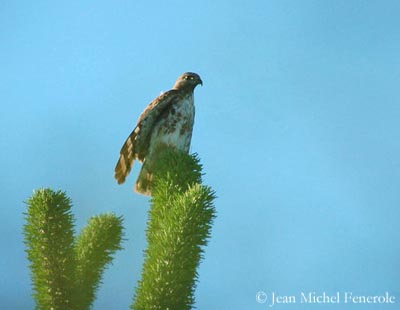
Buteo brachypterus
This raptor frequents all types of forest, and avoids the bare central plateau. It can be seen on rocky slopes up to 2300 metres of elevation.
It feeds on small vertebrates, taking frogs, lizards, snakes, small birds and mammals, and also crabs. As other buzzard species, it hunts from a perch and soars high above the island, and often in pairs.
The nest is made with sticks and built in high fork in tree, or sometimes wedged into an epiphyte, as well in primary forest as in adjacent cultivated areas.
The female lays two eggs in September-October, and the incubation lasts about 30-35 days. The young fledge 6-7 weeks after hatching. Usually, only one chick is reared.
This species is resident on Madagascar. The Madagascar Buzzard is common in its range and not currently threatened.
These African buzzards lead us directly to the typical buzzards which are found in several continents, with similar behaviour and appearance.